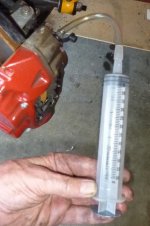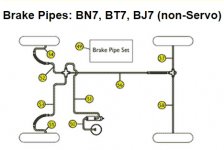trotti
Senior Member
Offline
Ok - need some advice on brakes before I pull my hair out. I have a 100-6 that sat for some time. Safe assumption that all the components are bad so I bought and installed all new wheel cylinders, shoes, hoses. Note, this car was restored shortly before it was left to sit.
I've bled and bled the brakes and can't get a high firm pedal. I can get a high firm brake on the second pump, but it is spongy if I let the pressure off and I feel a slow pulse in the pedal when I took it around the block. I think these issues are unrelated.
I have set each adjuster on the rear till they grip the drum then back off one. Similar up front for the two adjusters on each side. Hand brake is adjusted, but is a bit easy to work (no slack in the mechanism though). The pedal will hold pressure and doesn't sink, just low.
I've manual bled, gravity bled, and used pressure bleeding. I'm using DOT 4. Ideas?
I've bled and bled the brakes and can't get a high firm pedal. I can get a high firm brake on the second pump, but it is spongy if I let the pressure off and I feel a slow pulse in the pedal when I took it around the block. I think these issues are unrelated.
I have set each adjuster on the rear till they grip the drum then back off one. Similar up front for the two adjusters on each side. Hand brake is adjusted, but is a bit easy to work (no slack in the mechanism though). The pedal will hold pressure and doesn't sink, just low.
I've manual bled, gravity bled, and used pressure bleeding. I'm using DOT 4. Ideas?

 Hi Guest!
Hi Guest!

 smilie in place of the real @
smilie in place of the real @
 Pretty Please - add it to our Events forum(s) and add to the calendar! >>
Pretty Please - add it to our Events forum(s) and add to the calendar! >> 




